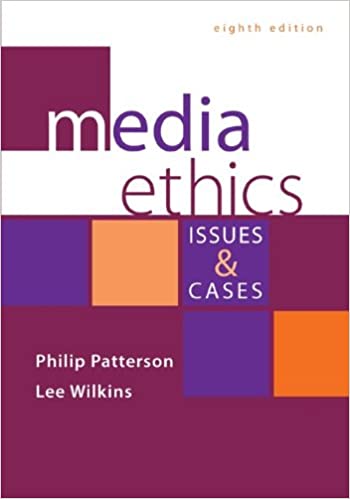
Media Ethics: Issues and Cases 8th Edition by Philip Patterson, Lee Wilkins
Edition 8ISBN: 978-0073526249
Media Ethics: Issues and Cases 8th Edition by Philip Patterson, Lee Wilkins
Edition 8ISBN: 978-0073526249 Exercise 1
Children, Privacy and Framing: The Use of Children's Images in an Anti-Same-Sex-Marriage Ad
YANG LIU
University of Wisconsin
The brief ballot measure read, "Only marriage between a man and a woman is valid or recognizable in California" (www.votergide.sos.ca.gov 2008) but it was packed with potential for conflict. So when the parents of some San Francisco first graders recognized their sons' and daughters' faces in an advertisement promoting California's controversial 2008 Proposition 8, which successfully sought to outlaw gay marriage in the state (www.protectmarriage.com 2008) they were shocked.
The ad picked up two scenes from a Web site news video clip originally produced by the San Francisco Chronicle for a news story that described 18 students attending their lesbian teacher Erin Carder's wedding. The newspaper story was a feature piece that took no position on Proposition 8. The story included an account of the wedding, which was held on October 10, 2008. In the newspaper piece, and on the 80-second accompanying video, the children's participation was described as "tossed rose petals and blowing bubbles... giggling and squealing as they mobbed their teacher with hugs." The story noted that it was a parent who suggested the trip and that because every student needed parental permission to attend, two students did not accompany their classmates to the wedding.
However, the central message of the advertisement was, "children will be taught gay marriage unless we vote Yes on Proposition 8" using two scenes with the children's images. The first showed the children in a group, and their faces are somewhat difficult to distinguish. The second showed a single child looking into the camera. The ad did not include the scenes of the children hugging their teacher that were part of the original news story. In addition, the creators of the ad altered the color tones in the scenes with children to be somewhat darker than the original news story as posted on the Chronicle Web site. The ad featuring the video clip of the wedding was one of several similar ads run in support of Proposition 8.
After viewing the ad, four of the parents of the children involved wrote a letter to the Yes-on-Proposition-8 campaign, demanding that the campaign stop running the ad. Their request was denied. The Chronicle did not question the use of the copyrighted material in the ad nor did it make a request that the ad be discontinued.
All advertisements, by virtue of their brevity, engage in selective use of facts. Evaluate whether this ad is within that professional mainstream in an ethical sense.
YANG LIU
University of Wisconsin
The brief ballot measure read, "Only marriage between a man and a woman is valid or recognizable in California" (www.votergide.sos.ca.gov 2008) but it was packed with potential for conflict. So when the parents of some San Francisco first graders recognized their sons' and daughters' faces in an advertisement promoting California's controversial 2008 Proposition 8, which successfully sought to outlaw gay marriage in the state (www.protectmarriage.com 2008) they were shocked.
The ad picked up two scenes from a Web site news video clip originally produced by the San Francisco Chronicle for a news story that described 18 students attending their lesbian teacher Erin Carder's wedding. The newspaper story was a feature piece that took no position on Proposition 8. The story included an account of the wedding, which was held on October 10, 2008. In the newspaper piece, and on the 80-second accompanying video, the children's participation was described as "tossed rose petals and blowing bubbles... giggling and squealing as they mobbed their teacher with hugs." The story noted that it was a parent who suggested the trip and that because every student needed parental permission to attend, two students did not accompany their classmates to the wedding.
However, the central message of the advertisement was, "children will be taught gay marriage unless we vote Yes on Proposition 8" using two scenes with the children's images. The first showed the children in a group, and their faces are somewhat difficult to distinguish. The second showed a single child looking into the camera. The ad did not include the scenes of the children hugging their teacher that were part of the original news story. In addition, the creators of the ad altered the color tones in the scenes with children to be somewhat darker than the original news story as posted on the Chronicle Web site. The ad featuring the video clip of the wedding was one of several similar ads run in support of Proposition 8.
After viewing the ad, four of the parents of the children involved wrote a letter to the Yes-on-Proposition-8 campaign, demanding that the campaign stop running the ad. Their request was denied. The Chronicle did not question the use of the copyrighted material in the ad nor did it make a request that the ad be discontinued.
All advertisements, by virtue of their brevity, engage in selective use of facts. Evaluate whether this ad is within that professional mainstream in an ethical sense.
Explanation
Analyzing the midrange issue gay marriag...
Media Ethics: Issues and Cases 8th Edition by Philip Patterson, Lee Wilkins
Why don’t you like this exercise?
Other Minimum 8 character and maximum 255 character
Character 255


